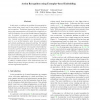Free Online Productivity Tools
i2Speak
i2Symbol
i2OCR
iTex2Img
iWeb2Print
iWeb2Shot
i2Type
iPdf2Split
iPdf2Merge
i2Bopomofo
i2Arabic
i2Style
i2Image
i2PDF
iLatex2Rtf
Sci2ools
CVPR
2008
IEEE
2008
IEEE
Action recognition using exemplar-based embedding
In this paper, we address the problem of representing human actions using visual cues for the purpose of learning and recognition. Traditional approaches model actions as space-time representations which explicitly or implicitly encode the dynamics of an action through temporal dependencies. In contrast, we propose a new compact and efficient representation which does not account for such dependencies. Instead, motion sequences are represented with respect to a set of discriminative static key-pose exemplars and without modeling any temporal ordering. The interest is a time-invariant representation that drastically simplifies learning and recognition by removing time related information such as speed or length of an action. The proposed representation is equivalent to embedding actions into a space defined by distances to key-pose exemplars. We show how to build such embedding spaces of low dimension by identifying a vocabulary of highly discriminative exemplars using a forward select...
Approaches Model Actions | Computer Vision | CVPR 2008 | Discriminative Exemplars | Human Actions | Static Key-pose Exemplars | Temporal Dependencies |
Related Content
| Added | 12 Oct 2009 |
| Updated | 12 Oct 2009 |
| Type | Conference |
| Year | 2008 |
| Where | CVPR |
| Authors | Daniel Weinland, Edmond Boyer |
Comments (0)

